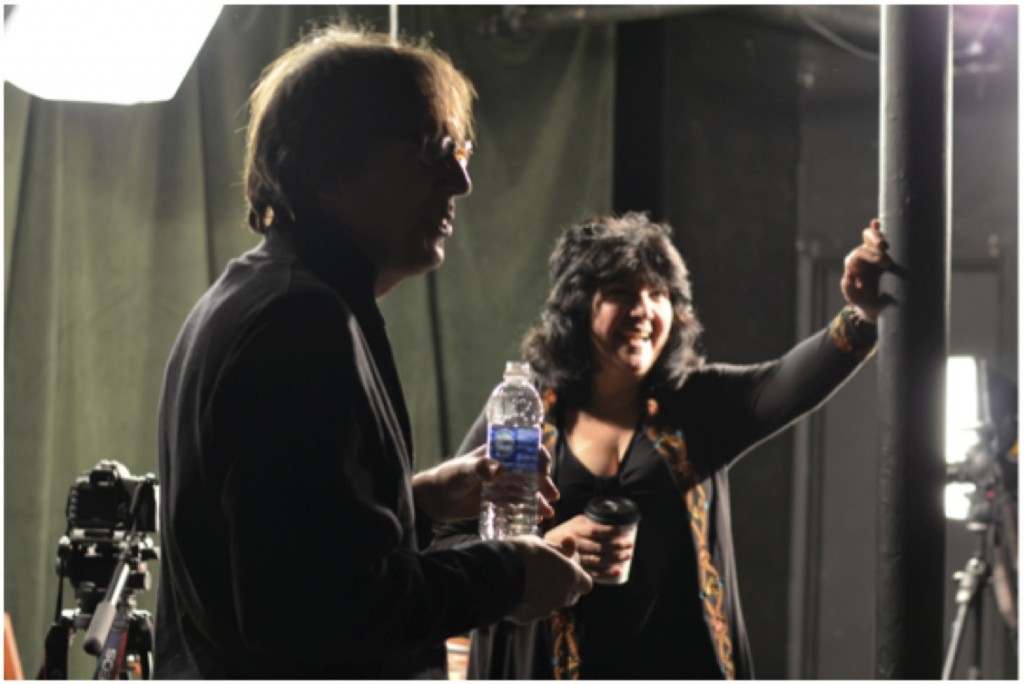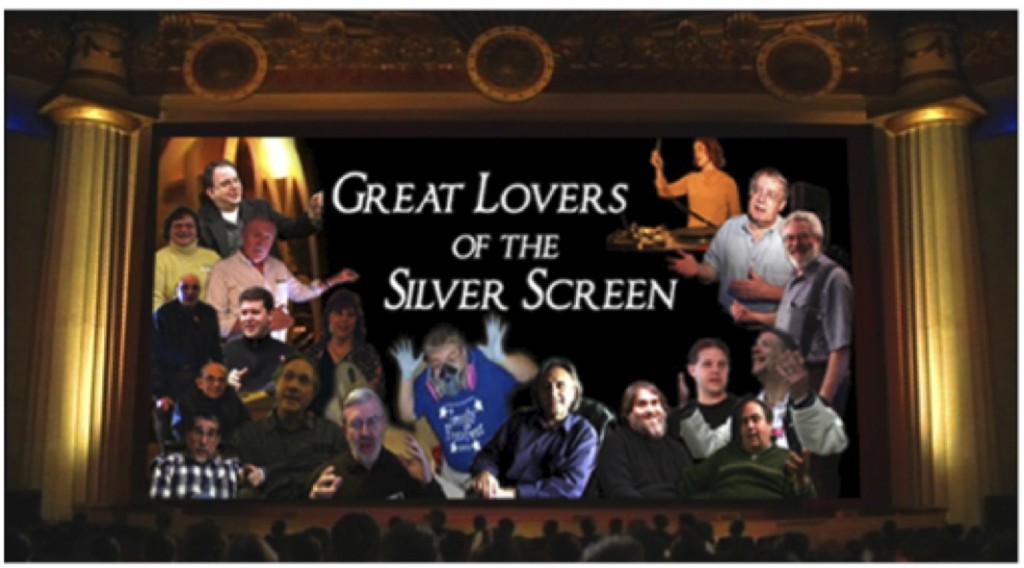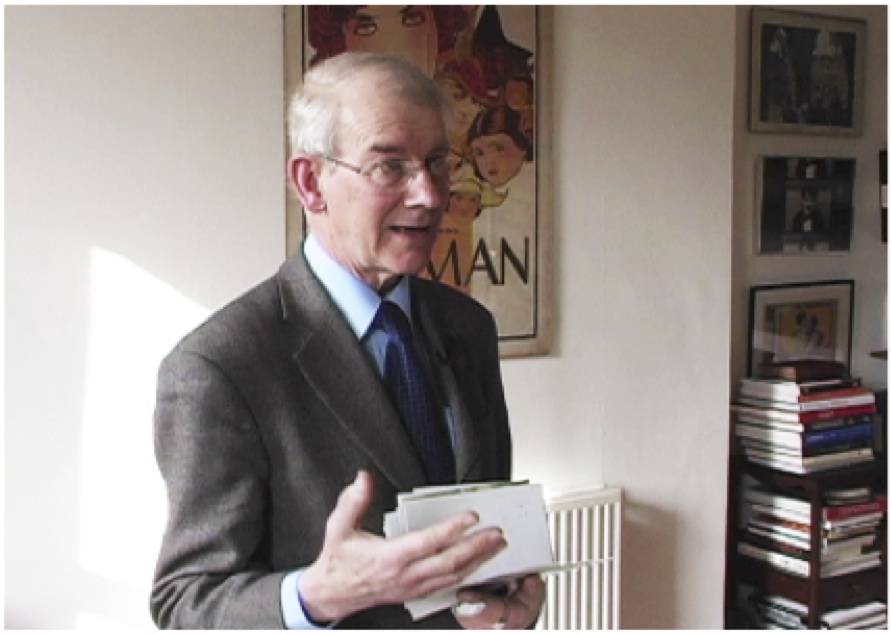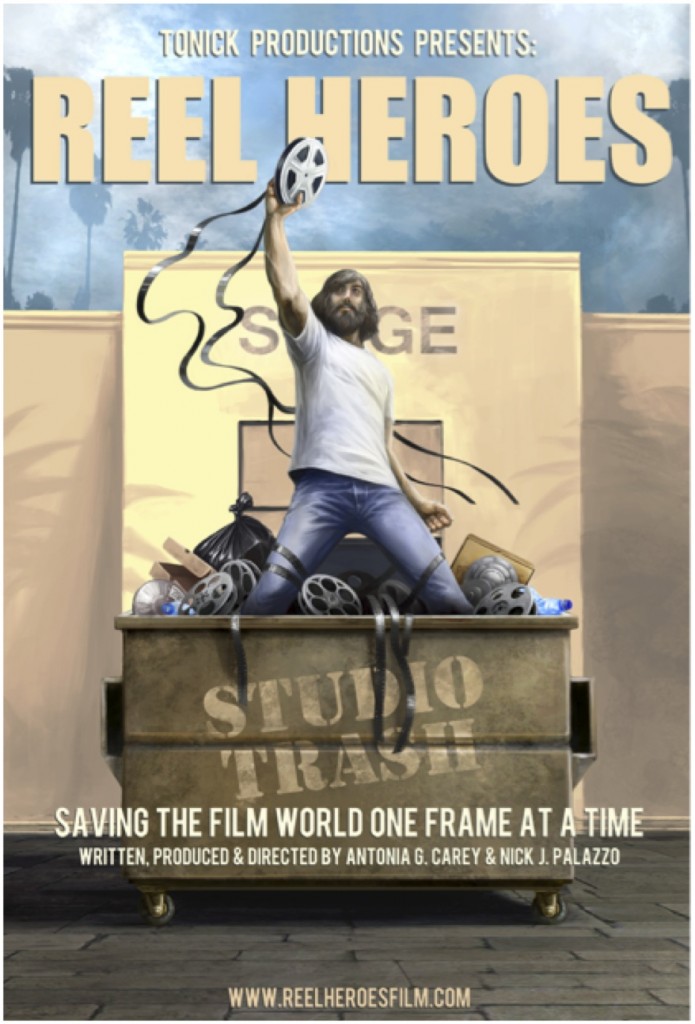I can’t remember when I first met Nick and Toni. It was in the far dim days of the past. I was aware of them for a long time before they actually spoke much with me. Film conventions aren’t the most social of gatherings, and the people who attend them are often not particularly social themselves. We’re not there to talk and schmooze. We’re there to see as many rare films as we can.
But Nick and Toni were always at these conventions, bubbly with enthusiasm. Eventually they told me about their documentary project. Several people told me that they were reluctant to talk to me because I seemed unapproachable! (I have to admit that this was partly the genesis of the Dr. Film character, because it was at that time I realized that I just come across as pompous and condescending, regardless of my intent, so I wrote the Dr. Film character knowing full well that I could play that!)
Their energy and enthusiasm for this project has continued unabated for years. They always have had some sense that it will be finished and it will get the word out. It’s a quality I admire in them, because it’s easy in this business to be told that your pet projects are worthless and to give up on them. They never have.
(I must also add, parenthetically, that I have seen their poster with me in it I was never that buff ever, so it is rather embarrassing. I have been known to get stuff out of the trash on occasion, though, so it is fair, I guess…)
Now, after a zillion years of working on this, they’re out of time and money, so they are turning to crowdfunding for cash to finish this. I completely support this (yeah, like why wouldn’t I?), so this is my contribution to the cause: getting the word out.

Q1: You two are not going to be familiar to a lot of readers here. Can you each give me a brief bio of who you are and what you do?
Wow Eric, first of all, thanks for having us on your blog!
T: I’m Toni Carey (Antonia G. Carey).
N: And I’m Nick Palazzo.
T: We go by TONICK (long O sound) because Nick noticed when we were dating that our names fit together and that’s just sort of a quick shorthand name for us so we’ve used it ever since. Like most of your readers, we’ve been classic film fans since we were kids. (This was, of course, when Fred Flintstone was young and people hadn’t even heard of videotape. You watched what was on one of the 5 or 6 television channels and that was your world.)
N: As kids we’d wait for the Sunday paper to grab the TV guide so we could plan our lives for the week around watching films on tv. As we got older, we both developed a love for foreign films as well. Toni’s mom worked nights but would let her stay home from school to watch classics like Black Orpheus or The Red Shoes on tv (as long as she maintained a B average in school). Her dad would let her stay up nights and watch classic film and taught her the difference between Ward Bond and James Bond.
T: Yeah, it would be decades before I’d realize that Dad’s home life was pretty rough and that he was actually raised by Hopalong Cassidy and Gene Autry because his parents would send him to the movies on Saturday mornings. Could you imagine sending your kids to the movies today and letting them be raised by the characters on screen now?
N: I’m first generation Italian-American so I was immediately drawn to films by Fellini, and Pasolini before branching out into Italian Neo-Realism.
When we were in our early 20s, (and single), we’d go to Facets Multimedia’s, a 60 seat theater in Chicago during the Christmas holidays where they’d screen Marcel Carne’s Children of Paradise annually. And after we met, and shared our love of movies, we discovered that we were going alone and sitting in that little theater together, but didn’t know it!
Toni: Coming from working class families, our folks couldn’t really afford college much less film school so we both worked office jobs during the day and once we got together and talked about our dreams of making films, decided to do whatever we could to learn how to make film.
Nick: Toni had done some acting over the years and got cast in a student film at Columbia College here in Chicago. She explained she was really interested in working behind the camera. They said they needed her to act and she bartered a deal where we would trade our skills (acting and being a set Production Assistant) in exchange for second hand film lessons from the students. We worked on a lot of student films!
Toni: They were good kids and taught us how to read light meters, change film and some basic lighting. When we got into writing screenplays, Nick’s background as a creative writer and an award-winning poet really helped. Eventually we sold our first screenplay.
Nick: We tried learning wherever we could. We took classes from different places including Chicago Filmmakers where we had a teacher, an Editor for Lucasfilm named Kate MacDonald, who saw how hard-core we were and offered us a gig apprenticing on a film she was working on. It was called Amerikan Passport directed by Reed Padget, a kid who had taken his film school money and traveled the world doing a documentary with it. It actually won best Documentary at Slamdance in 1999.
Toni: Of course at the same time we were shooting little films and entering them in different festivals. Always trying to emulate great filmmakers like Jean Cocteau or even the silent films.
Q2: Tell us about the documentary you’re making.
It’s called Reel Heroes. But once upon a time, it was called Great Lovers of the Silver Screen. We thought that title was too flowery. (“Actually Nick did,” says Toni) And we didn’t want people in line at the film box office to say that long title.

We called it that because it’s about a group of underground film collectors and preservationists working outside the system, to save and share whatever films they can get their hands on. We’re trying to show how heroic they are, especially considering that they’re supporting themselves with day jobs, or whatever funding they can acquire.
Having become a video collector back in its infancy (paying $80, I remember for a really terrible video copy of Jean Cocteau’s La Belle et La Bette), we discovered a publication called “Big Reel,” which at the time, was a sort of swap meet on paper for film collectors. I remember calling about a festival in New York and talking to a really sweet guy about how we could attend. The man was Phil Serling and he was one of the founders of the Syracuse New York Cinefest.
Turned out we couldn’t go so we tried a festival that was closer called Cinesation. It was held in Saginaw, Michigan at the time in a 2000 seat theater called the Temple. We were so entranced by the whole experience of being in a movie palace-type theater, and seeing all the incredible films we’d never be able to see on TV or DVD, we were hooked!

Somewhere during this time, Toni was able to land a gig as apprentice editor in Chicago working for Academy-Award winning editor Gerry Greenberg (French Connection, Apocalypse Now, etc.) on a John Hughes (Breakfast Club, etc.) production and got in the Editor’s union.
Once we learned that conventions like this were being held in other parts of the country, like Columbus, Ohio, Syracuse, New York and even Los Angeles, we were like, “Oh, we’ve GOT to go to as many of these as possible!” We then devoted our vacation time to traveling to these conventions and seeing as many of these films, and meeting all these great people. Something dawned on us after going to a few of these conventions, which was: “Hey, no one’s ever done a film about these guys. We should do one.”
So we brought a camera, lights and plenty of enthusiasm and spent the last 12 years traveling all over the country (including trips to London and Paris) to interview as many film collectors as possible, and capturing the activities at these various conventions.
And the rest, as they say, is history.
Q3: What inspired you to do this?
At first we thought it was going to be a kind of “look how quirky and sweet these people are” type documentary.
But the more people we interviewed, we were uncovering some serious stuff; for example, that the FBI staged a series of investigations and raids into people’s homes who were film collectors in the 1970s. The most famous person busted for this was British actor Roddy McDowall. (P.S. anyone who knew Roddy or was involved with the film collector witch hunt of the 1970s that’s willing to be interviewed, please contact us! We’d love to tell more of this story.) Then we learned that even though our favorite films were made in 1927 and 1928 and should have been out of copyright by the early 1970s, we still couldn’t see or share them with friends due to the fact that copyright laws had been unfairly renewed and extended so that they wouldn’t be available until something like 2025. It’s really hard to get people interested in these early works when they are being unfairly kept from the public domain. We realize we’re preaching to the choir mentioning this to you, Eric, as you have MANY good stories about this yourself but then people will have to see the film to hear some of them 😉
So our intention then changed to, “let’s shine a light on what’s happening to film and our film history” before it’s too late.
Q4: I know that I’m in this (it started way back when my beard was still dark.) Who else do you profile?
Hey, there’s always Grecian Formula for Men, so it’s still not too late, ha.
We profile collectors from pretty much all walks of life, from kids who are collecting their first super 8 silent comedy films like AJ Boggs, to people working in the industry like Gremlins director Joe Dante, and Hollywood VFX Professionals like Linda and Miller Drake.


But I guess the subject we’re most proud (and lucky) to have is Kevin Brownlow. He’s always been one of our personal heroes because his work has had such an impact on our lives, ranging from the Hollywood series to of course the monumental restoration of Napoleon. It was so wonderful that the Academy finally recognized him for all of his amazing work with an Honorary Oscar for Film Preservation – the first ever given.

We also had the amazing opportunity to interview Bruce Lawton & Ben Model of the Silent Clowns Film Series out of New York which eventually led to a once-in-a-lifetime opportunity to meet Bruce’s legendary grandfather, Karl Malkames. Karl actually takes us through his collection of historic film cameras, like one of those that captured the Hindenburg Zeppelin disaster and another that accompanied Admiral Byrd to the North Pole. Really incredible stuff! He also gives us a glimpse on camera of his famous souped up Biograph printer, which he motorized in order to put over a million feet of film thru for various archives in order to reprint copies from original Biograph negatives. Unfortunately, Mr. Malkames passed away in 2010 but we were so lucky to get the footage because his collection is not open to the public.


And in case you didn’t realize when we made YOU the focus of one of our film poster designs, (you do cut a nice figure leaping triumphantly out of a studio dumpster!) you are certainly one of our most important subjects as well. We’re excited to allow people see you at your best up against some staggering odds as you bring film to new audiences. It’s amazing all the films you’ve introduced us to over the years at these various conventions and the work you’ve accomplished so far with the restoration of Keaton’s Seven Chances color sequence and the King of the Kongo serial! Now, if only we could trim your beard…ha!

And you’re doing this all by yourself! If that’s not heroic, then we don’t know what is.
Q5: You’re starting an IndieGoGo campaign. What are you trying to accomplish with this?
We’re trying to obviously get the word out to the crowd funding world and raise enough money to cover the costs of post-production, legal work, accounting, perk fulfillment and a host of other things. I guess the thing worth mentioning is that ultimately, we aren’t making any money on the campaign, even if it gets fully funded. We’ve put too much of our own money into the film already. At this point, we’re just trying to get it finished and in a way that brings honor to everyone involved.
A really cool perk we’re offering for the holiday season is the “Credit for Christmas” perk that allows a funder to buy a loved one screen credit for a present. Once they purchase the perk and give us the to and from names, we create and email them a neat certificate they can print out and package up as a present to open (suitable for framing of course).

One disadvantage we’re finding is that because we’re known in collector circles but not generally, we don’t have any social media following. We only joined Facebook and Twitter a few weeks ago, so we have some catching up to do in terms of getting the word out there, but our page is already getting some traction. If any your readers can help spread the word, that would really be appreciated.
Q6: I know you’ve recorded a ton of footage. How much footage do you have, and what’s your goal to end up with?
Gosh, we have over 80 hours of footage and that’s before we ask for some clips we really need in order to tell the story. We have the last known on-camera interviews not only with Karl Malkames but also Sam Rubin, the founder of Classic Images and co-founder of the original classic film conventions and Steven Haynes, the co-founder of the Columbus, Ohio Cinevent film convention before his untimely death earlier this year.
While we definitely have enough footage to do a mini-series, we are trying to get the film down to a run time of somewhere under two hours.
Q7: What’s the message you’d like your audience to get when they see your film? Do you want them to be inspired to watch older films, or go into preservation, or just to know what some of the film preservationists do?
Yes! All of the above. Years ago there were a lot of documentaries about preservation and restoration but these days, we’re concerned people aren’t really even familiar with the importance of film. To be fair, they don’t really have many places where they can get access to it. Even the multiplexes are going digital. We think the story of the fight all of our guys and gals are waging against great odds in trying to keep film alive is an heroic one. And also, it’s a great chance to meet a lot of loving, funny, brilliant folks that should inspire all of us to go after what we want, despite the odds.
Ultimately, the message is about Love and we love movies!
Q8: What did you learn about the world of film and preservation while making this film? Were there unexpected things that you discovered?

Well, we always considered archives as places where everything was kept. We certainly didn’t realize that there isn’t room for every film ever made to be stored as film in their vaults or that people couldn’t necessarily get access to them if they wanted to without special permissions. We didn’t realize that studios don’t even always know what film copyrights they hold and that there is actually such a thing as an orphan film where no one owns the rights so no one can ever see it.

Then there’s all the “woo woo” stuff: As you can imagine over the past 12 years, everyone including us has evolved a bit into other interests and areas of study. For us, it’s been an interest in let’s call it, the occulted rules of wave and particle theory of quantum physics that make life so interesting. In pursuing those fields of study, Nick and I became certified Infinite Possibilities trainers by Mike Dooley and we have certifications in Solar Spectrum Sound Therapy healing modalities and systems including Sound Therapy, and Brainwave Entrainment. We’re also studying with Dr. Joe Dispenza whose work involves neurology and its effect on the quantum field.
Who cares and what does all that mean? It means, we took a step back and noticed that part of what we’ve managed to capture on film is people making their dreams come true. We realized that many of them are unconsciously using elements of these teachings to change their lives. And as we studied these concepts, we noticed that there was something else afoot involving film; studies that showed film’s curative powers and how because of the way our brains are built how seeing certain films is, to the brain, the same as having the experience first-hand. That led us to the question, “if seeing is experiencing to our brains, and all that is available to watch are computer graphic war, violence and dysfunctional behavior films, then is there possibly a larger reason why the classic films of the past aren’t accessible to modern audiences?”
Boy we bet you didn’t expect that answer! Ha! But that is one of the things we’ll be touching on in the film.
Q9: Once this film is finished, what are your plans for it? Are you going on the road, etc?
Our dream is to premiere the film at the Telluride Film Festival in 2016. Telluride holds a very special place in our hearts as the people who used to program Facets Multimedia’s Children of Paradise showing now run that festival. And that is where we first met Kevin Brownlow face to face. It’s a place where film (not commerce) matters most and we’d like the opportunity for our film to premiere there. Of course it’s all predicated on the film being good enough and being done in time for their deadline (July 2016) which is why we’re running the Indiegogo campaign. Without the funding, we can’t make the deadline.
Q10: I always get interviewed myself by people who don’t quite understand what I’m doing, so I’m sensitive to the fact I may miss the point. Tell me what question I should have asked you and answer that, please.
Well, there’s no way you’d know to ask us this, Eric but you might ask about the newly surfaced controversy involving our film. We had two subjects pull out based on a 1 minute and 5 second sneak peek trailer that dealt with the FBI witch-hunt portion of the film. The trailer’s been taken down and of course is no longer available to be seen since we had to recut it to omit those folks but it actually opened the way to an exciting new possibility!
We have the opportunity to interview collector extraordinare, Stu Shostak and young blood cartoon preservationist Tommy Jose Stathes! Stu’s big heart and wonderful personality would be a fantastic addition to our lineup of heroes and Tommy is just such an incredible younger generation preservationist/collector/sharer that he would really show our audience that there is hope for the future of access to rare film and cartoons. Again, it will be up to the Indiegogo campaign if we can make these interviews happen but we are excited these guys exist and hope to tell their stories as well.
